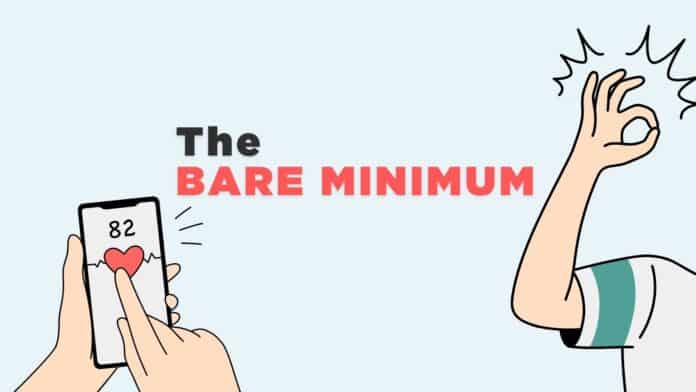In a world brimming with constant demands, information overload, and seemingly endless to-do lists, the concept of the “bare minimum” has emerged as a beacon of clarity and focus.
While the term might initially evoke thoughts of mediocrity or settling for less, it’s precisely the opposite—a path to liberation and effectiveness. In a culture that often glorifies busyness and excess, embracing the bare minimum is a revolutionary act of simplification and essentialism.
This article delves into the profound art of living and working with less—cutting through the noise and discarding the non-essential. We explore how the bare minimum approach can enhance productivity, creativity, and overall well-being.

From decluttering our physical spaces to streamlining our schedules, we uncover the transformative power of stripping away distractions to reveal what truly matters.
Join us as we unravel the secrets of the bare minimum lifestyle, a philosophy that celebrates the freedom found in simplicity and the beauty of focusing on what truly brings fulfilment, whether you’re seeking balance in your personal life or looking to optimize your professional pursuits.
The bare minimum awaits as a pathway to rediscovering intention, purpose, and the essence of thriving. Let’s embark on a journey of unburdening and rediscovering the joy of less is more.
Read Also: 5 Ways to Improve Your Time Management
Bare Minimum
The term “Bare Minimum” refers to the absolute essential or minimal level required to achieve a specific outcome or meet a certain standard. It is about embracing simplicity and eliminating unnecessary complexities, distractions, or excess in various aspects of life, work, or decision-making.
In a world characterized by constant demands, information overload, and the perpetual pursuit of more, the concept of the bare minimum challenges the prevailing culture of always striving for bigger, better, and busier.
Instead, it invites individuals to evaluate their priorities, identify what truly matters, and focus their efforts on what is necessary to achieve their goals.
The bare minimum approach can be applied in various contexts:
- Simplifying Personal Life: By decluttering physical spaces, managing time more intentionally, and prioritizing self-care, individuals can achieve a greater sense of balance and well-being.
- Streamlining Work: In professional settings, the bare minimum involves concentrating on core tasks, eliminating busy work, and concentrating on high-impact activities to boost productivity and efficiency.
- Setting Realistic Goals: Embracing the bare minimum philosophy allows individuals to set attainable objectives and avoid spreading themselves too thin, resulting in more meaningful achievements.
- Decision-Making: When faced with choices, the bare minimum principle helps focus on the essential factors and make informed decisions without being overwhelmed by irrelevant details.
- Time Management: Adopting the bare minimum mindset enables individuals to allocate their time and energy to what matters most, preventing burnout and maximizing productivity.
It is essential to recognize that embracing the bare minimum is not synonymous with settling for mediocrity or laziness. Rather, it is about exercising discernment, freeing ourselves from the burden of excess, and uncovering the true essence of what brings meaning and fulfilment to our lives.
See Also: 5 Apps That Improve Time Management
Bare Minimum in a Relationship
In the context of a relationship, “bare minimum” refers to the lowest level of effort or attention a person can give to maintain the relationship without putting in any additional care, consideration, or emotional investment. It implies doing just enough to keep the relationship going without actively nurturing or contributing to its growth and well-being.
Embracing the bare minimum in a relationship can be detrimental and harmful. It may lead to feelings of neglect, dissatisfaction, and a lack of emotional connection between partners. In healthy and fulfilling relationships, both individuals should be willing to invest time, effort, and care to build a strong and lasting bond.

A successful and thriving relationship involves:
- Communication: Open, honest, and effective communication is essential for understanding each other’s needs, feelings, and perspectives. Regularly expressing love, appreciation, and concerns helps foster emotional intimacy and trust.
- Emotional Support: Being there for one another during life’s highs and lows is vital. Providing emotional support, empathy, and validation can strengthen the bond and create a secure and safe environment.
- Quality Time: Spending meaningful time together, engaging in shared activities, and creating cherished memories are crucial to nurturing the relationship.
- Showing Affection: Demonstrating affection through physical touch, kind gestures, and expressions of love reaffirms the emotional connection between partners.
- Respecting Boundaries: Respecting each other’s individuality and setting healthy boundaries is essential for fostering mutual respect and understanding.
- Partnership: A strong relationship involves mutual partnership and shared responsibilities in various aspects of life, such as parenting, finances, and household duties.
- Growing Together: Supporting each other’s personal growth and aspirations while working together as a team to achieve shared goals.
Choosing the bare minimum approach in a relationship can lead to feelings of being unappreciated, unloved, or taken for granted. Over time, this may lead to a breakdown in communication and emotional distance between partners.
A relationship to thrive and flourish requires active participation, continuous effort, and a genuine commitment from both partners. By prioritizing the emotional well-being of each other, nurturing the connection, and investing in the relationship, couples can build a strong and fulfilling bond that stands the test of time.
Read Also: 5+ Steps to Set Priorities For Improving Efficiency
Sign of Bare Minimum in a Relationship
Signs of the “bare minimum” in a relationship can be indicative of one or both partners not fully investing or actively participating in nurturing the relationship. It may suggest a lack of effort, emotional disengagement, or neglect of essential aspects that contribute to a healthy and fulfilling partnership.
Some signs of the “bare minimum” in a relationship include:
- Lack of Communication: Communication is essential for understanding each other’s needs, emotions, and concerns. If one or both partners avoid meaningful conversations, only engage in surface-level discussions, or consistently fail to share thoughts and feelings, it may be a sign of minimal emotional investment.
- Infrequent Quality Time: Spending meaningful time together is crucial for building emotional intimacy and maintaining a strong connection. If partners consistently spend little time together and prioritize other activities over spending time as a couple, it may indicate a lack of prioritization in the relationship.
- Absence of Affection: Expressing affection, such as physical touch, hugs, kisses, and expressions of love, is vital for fostering emotional closeness. If partners rarely show affection or avoid physical intimacy altogether, it may suggest emotional distance.
- Minimal Emotional Support: Providing emotional support during challenging times is fundamental to a healthy relationship. If one partner consistently fails to offer empathy, understanding, or support during difficult moments, it may indicate emotional detachment.
- Ignoring Relationship Issues: Avoiding or dismissing relationship problems and conflicts instead of addressing them constructively may signify a lack of commitment to resolving issues and improving the relationship.
- Minimal Effort in Shared Responsibilities: A healthy relationship involves shared responsibilities, such as household chores, parenting, and financial decisions. If one partner consistently contributes little to shared responsibilities, it may lead to feelings of inequality and strain on the relationship.
- Prioritizing Individual Interests: While maintaining individual interests and hobbies is healthy, prioritizing personal pursuits over the relationship’s well-being can lead to emotional distance and neglect.
- Emotional Distance: Partners may exhibit emotional distance if they avoid vulnerability, fail to express love or appreciation, or become emotionally unavailable.
- Decreased Interest in Future Planning: A lack of interest or participation in future planning, such as discussing long-term goals, shared dreams, or commitments, may signify a disinterest in building a future together.
It is essential to address any signs of the “bare minimum” in a relationship early on to prevent further emotional distance and dissatisfaction. Open and honest communication is key to understanding each other’s feelings and needs, working through issues, and re-establishing a meaningful connection.
When both partners actively invest in the relationship, they can create a loving and fulfilling partnership built on trust, respect, and emotional intimacy.
Bare Minimum in Daily Lives
“Bare minimum” in daily life refers to the minimal or essential effort required to fulfil basic obligations or tasks without going above and beyond. It involves simplifying daily routines and activities to focus on what is necessary and avoid unnecessary complexity or unnecessary commitments.
Incorporating the bare minimum approach in daily life can be beneficial in several ways:
- Time Management: By focusing on essential tasks and prioritizing what truly matters, individuals can manage their time more efficiently and avoid feeling overwhelmed by an excessive to-do list.
- Stress Reduction: Embracing the bare minimum reduces stress by eliminating unnecessary pressures and commitments, allowing individuals to focus on what brings them joy and fulfilment.
- Minimalism: The bare minimum aligns with the principles of minimalism, encouraging individuals to declutter their physical and mental spaces, leading to a sense of clarity and peace.
- Better Decision-Making: Simplifying daily choices by focusing on the essential aspects of life can lead to better decision-making and more intentional actions.
- Mindfulness: The bare minimum encourages being present and mindful in daily activities, appreciating the simplicity of life’s essentials.
- Self-Care: Prioritizing self-care and well-being becomes easier when individuals focus on their core needs and avoid overcommitting themselves.
Examples of incorporating the bare minimum in daily life include:
- Simplified Morning Routine: Instead of rushing through an elaborate morning routine, focus on the essentials like hydration, a quick stretch, and a healthy breakfast.
- Streamlined To-Do List: Prioritize the most important tasks for the day and avoid overloading the to-do list with non-essential activities.
- Saying “No” When Necessary: Be selective about commitments and learn to decline invitations or requests that don’t align with your priorities.
- Digital Detox: Limit screen time and avoid excessive scrolling on social media to free up time for meaningful activities and relationships.
- Reducing Clutter: Declutter living spaces and possessions to create a more organized and peaceful environment.
- Quality Over Quantity: Focus on the quality of experiences and interactions rather than trying to do too much quickly.
While incorporating the bare minimum in daily life, it is crucial to strike a balance. It does not mean neglecting important responsibilities or becoming complacent. Instead, it involves intentional choices to simplify and focus on the essentials that truly matter, leading to a more meaningful and purposeful daily life.
Bare Minimum in a Workplace
In a workplace, the concept of “bare minimum” refers to the minimum level of effort or output required from employees to meet the basic expectations of their job roles. However, it’s essential to clarify that aiming for the “bare minimum” is not an ideal approach to work, as it implies minimal effort and may lead to subpar performance and a lack of motivation.
Instead, workplaces should encourage a culture of excellence, where employees are motivated to perform at their best, go above and beyond, and take pride in their work. To achieve optimal results, employers and employees should strive for continuous improvement, collaboration, and innovation.

Here are some important considerations for fostering a positive work environment that goes beyond the “bare minimum”:
- Setting Clear Expectations: Employers should communicate clear and specific job expectations to employees, outlining the desired outcomes and standards for performance.
- Providing Support and Resources: Employers should ensure that employees have the necessary tools, resources, and training to perform their tasks effectively.
- Recognizing and Rewarding Excellence: Acknowledging and rewarding exceptional performance can boost employee morale and motivation, encouraging them to surpass the bare minimum.
- Encouraging Collaboration: Promote teamwork and collaboration among employees, fostering a sense of camaraderie and shared responsibility for achieving collective goals.
- Offering Opportunities for Growth: Providing professional development and advancement opportunities can motivate employees to continuously improve and contribute their best efforts.
- Emphasizing Work-Life Balance: Encouraging work-life balance prevents burnout and maintains a motivated and engaged workforce.
- Promoting Employee Well-Being: Prioritizing physical and mental well-being can positively impact productivity and job satisfaction.
- Regular Performance Feedback: Providing constructive feedback and coaching can help employees understand areas for improvement and encourage continuous learning.
- Celebrating Achievements: Recognizing and celebrating individual and team accomplishments can boost employee morale and create a positive work environment.
- Leading by Example: Leadership should demonstrate a commitment to excellence and be role models for employees.
Striving for excellence and fostering a culture of continuous improvement is essential for the success of any organization. Encouraging employees to go beyond the “bare minimum” promotes a sense of pride, ownership, and satisfaction in their work, ultimately leading to higher productivity, employee retention, and overall success.
The “bare minimum” concept is a multifaceted idea that can be applied to various aspects of life, work, and relationships. At the same time, it can imply the minimum effort required to meet basic obligations.
It is important to recognize that embracing the bare minimum as a guiding principle may lead to mediocrity or complacency. Instead, the true essence of the “bare minimum” lies in intentional simplicity, prioritization, and essentialism.
In our personal lives, simplifying and decluttering can bring a sense of clarity, focus, and contentment. By identifying what truly matters, we can create a purposeful and meaningful existence free from the burdens of excess and unnecessary distractions.
The “bare minimum” should not be the ultimate goal in the workplace. Instead, fostering a culture of excellence, collaboration, and continuous improvement empowers individuals to excel in their roles, find fulfilment in their work, and contribute to the organisation’s collective success.
Read Also: To-Do Lists: Why They Are Important
In relationships, going beyond the “bare minimum” is vital for nurturing emotional connection, fostering trust, and building strong bonds. By investing time, effort, and empathy, we create thriving partnerships that withstand the tests of time and challenges.
FAQs for Bare Minimum
What does bare minimum mean?
The smallest possible quantity or the least fulfilling, but still adequate, condition that is required, acceptable, or suitable for some purpose.
What does bare minimum living mean?
Living with just the bare minimum can be difficult, as it means having limited resources and access to necessities such.
Is it bear or bare minimum?
Bare minimum means “the least possible.” Keep costs to a bare minimum. Bear weight means “support.” The builders designed the structure to bear weight.
What is it called when someone does the bare minimum at work?
The practice of employees purposely doing the bare minimum to stay employed and nothing more.
What is the bare minimum for a friendship?
There are no set rules to what a friendship is by any means, but we think it can be agreed on that the bare minimum any friend should do is be able to sit, listen and understand your feelings when you need them to.





